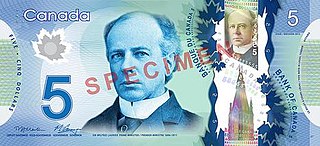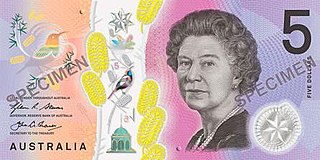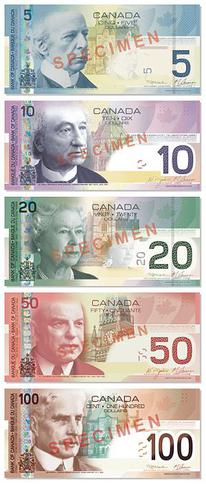This article has multiple issues. Please help improve it or discuss these issues on the talk page . (Learn how and when to remove these template messages)
|
| (Canada) | |
|---|---|
| Value | 50 Canadian dollars |
| Width | 152.4 mm |
| Height | 69.85 mm |
| Security features | Transparent windows, metallic portrait, watermark, EURion constellation, tactile marks, registration device, raised printing, UV printing |
| Material used | Polymer |
| Obverse | |
 | |
| Design | William Lyon Mackenzie King |
| Reverse | |
 | |
| Design | CCGS Amundsen; arctic in Inuktitut; map of the northern regions of Canada |
The Canadian fifty-dollar note is one of the most common banknotes of the Canadian dollar. It is sometimes dispensed by ATMs but not as commonly as the $20 note.
From the Frontier (2011–present) series. The current 50-dollar note is predominantly red in colour and is printed on polymer (plastic), not paper. In addition to being more durable than the cotton-based paper they replaced, the new notes are also more secure. It was introduced into circulation on March 26, 2012 and is part of the new Polymer Series (2011). The front features a portrait of William Lyon Mackenzie King. A large clear window runs vertically on the right hand side of the face of the note. There is a second metallic hologram image of King on the top of the window, and a hologram image of the Centre Block of the Canadian Parliament buildings on the bottom of the window. [1] A ribbon made of multiple number 50s weaves between the duplicate King portrait and the Centre Block. The top left corner of the note's face has a metallic maple leaf surrounded by a transparent border.
The reverse side depicts the Canadian Coast Guard Ship (CCGS) Amundsen, a research icebreaker. Because the note is plastic, the same clear windows and metallic images that are seen on the front are seen on the reverse. As well as textured printing, this design incorporates a special tactile feature similar to Braille dots for the blind indicating the denomination.
From the Canadian Journey (2004) series. It features, on the front, a portrait of William Lyon Mackenzie King, the coat of arms, and a picture of the Peace Tower of the Parliament buildings. Security features visible from the front include a hologram strip along the left side, depicting the number 50 alternated with maple leaves; a watermark of King's portrait; and a broken-up number 50, which resolves itself when backlit. The reverse side depicts themes in Canadian human rights history, such as the Famous Five celebrating the Persons case, and a volunteer medal commemorating Thérèse Casgrain; it also has a quotation from the Universal Declaration of Human Rights. The reverse also has a visible security feature: an interleaved metallic strip, reading '50 CAN' repeatedly along its length.
From the Birds of Canada (1988) series. It features, on the front, a portrait of William Lyon Mackenzie King, the coat of arms, and a picture of the Centre Block of Parliament. On the reverse side is a wilderness scene with a snowy owl. It also had a holographic sticker showing the amount in the top left side, which changes from gold to green when tilted. The front has a wavy background of extremely small but still clear numeral 50s. This "micro-printed" background is very hard to copy. Some of the printing is textured, and the raised ink can be felt.
All Canadian banknotes underwent a major redesign, beginning in 1986, partially to incorporate some of the latest anti-forgery methods. Notes continued to be improved, with the design placed into circulation on November 17, 2004. Notes were printed on paper composed of pure cotton at two Ottawa companies contracted for the purpose: the Canadian Bank Note Company and BA International Inc., a part of the Giesecke & Devrient GmbH group of companies.
Each $50 banknote in the 1988 series was sprinkled with special green ink dots that glow when exposed to ultraviolet light. The ink can be scraped off, so worn notes tend to have fewer, if any, glowing dots. These were replaced with more permanent ultraviolet-detected threads in the new notes, as well as an ink imprint of the coat of arms.
As with all modern Canadian banknotes, all text is in both English and French.
| Series | Main colour | Obverse | Reverse | Series Year | Issued | Withdrawn |
|---|---|---|---|---|---|---|
| 1935 Series | Brown | Prince Albert, Duke of York | Modern Inventions allegory | 1935 | 11 March 1935 | |
| 1937 Series | Orange | George VI | Modern Inventions allegory | 1937 | 19 July 1937 | |
| 1954 Series | Orange | Elizabeth II | Lockeport Beach, Nova Scotia | 1954 | 9 September 1954 | |
| Scenes of Canada | Red | William Lyon Mackenzie King | Musical Ride of the Royal Canadian Mounted Police | 1975 | 31 March 1975 | 1 December 1989 |
| Birds of Canada | Red | William Lyon Mackenzie King | Snowy owl | 1988 | 1 December 1989 | 17 November 2004 |
| Canadian Journey Series | Red | William Lyon Mackenzie King | The Famous Five and Thérèse Casgrain; quotation from the Universal Declaration of Human Rights | 2004 | 17 November 2004 | 26 March 2012 |
| Frontier Series | Red | William Lyon Mackenzie King | CCGS Amundsen in arctic waters, a map of Canada's North, and the word 'Arctic' in Inuktitut (ᐅᑭᐅᖅᑕᖅᑐᖅ, ukiuqtaqtuq) | 2012 | 26 March 2012 |













